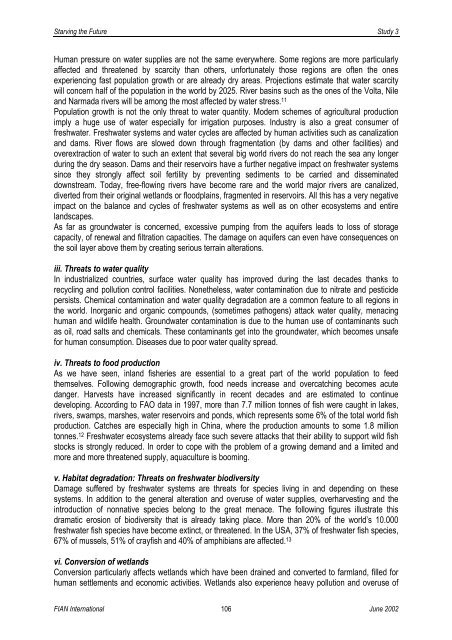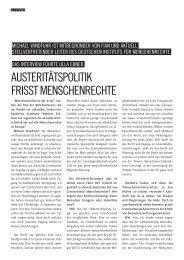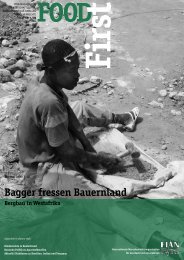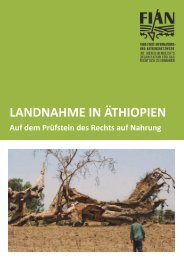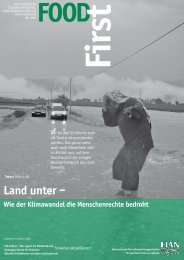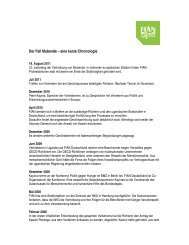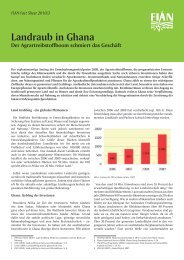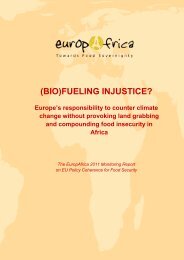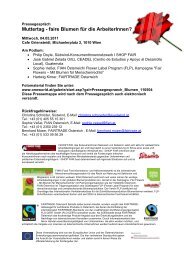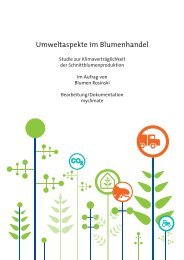Study 3: Ecodestruction and the Right to Food: The Cases of Water ...
Study 3: Ecodestruction and the Right to Food: The Cases of Water ...
Study 3: Ecodestruction and the Right to Food: The Cases of Water ...
You also want an ePaper? Increase the reach of your titles
YUMPU automatically turns print PDFs into web optimized ePapers that Google loves.
Starving <strong>the</strong> Future <strong>Study</strong> 3<br />
Human pressure on water supplies are not <strong>the</strong> same everywhere. Some regions are more particularly<br />
affected <strong>and</strong> threatened by scarcity than o<strong>the</strong>rs, unfortunately those regions are <strong>of</strong>ten <strong>the</strong> ones<br />
experiencing fast population growth or are already dry areas. Projections estimate that water scarcity<br />
will concern half <strong>of</strong> <strong>the</strong> population in <strong>the</strong> world by 2025. River basins such as <strong>the</strong> ones <strong>of</strong> <strong>the</strong> Volta, Nile<br />
<strong>and</strong> Narmada rivers will be among <strong>the</strong> most affected by water stress. 11<br />
Population growth is not <strong>the</strong> only threat <strong>to</strong> water quantity. Modern schemes <strong>of</strong> agricultural production<br />
imply a huge use <strong>of</strong> water especially for irrigation purposes. Industry is also a great consumer <strong>of</strong><br />
freshwater. Freshwater systems <strong>and</strong> water cycles are affected by human activities such as canalization<br />
<strong>and</strong> dams. River flows are slowed down through fragmentation (by dams <strong>and</strong> o<strong>the</strong>r facilities) <strong>and</strong><br />
overextraction <strong>of</strong> water <strong>to</strong> such an extent that several big world rivers do not reach <strong>the</strong> sea any longer<br />
during <strong>the</strong> dry season. Dams <strong>and</strong> <strong>the</strong>ir reservoirs have a fur<strong>the</strong>r negative impact on freshwater systems<br />
since <strong>the</strong>y strongly affect soil fertility by preventing sediments <strong>to</strong> be carried <strong>and</strong> disseminated<br />
downstream. Today, free-flowing rivers have become rare <strong>and</strong> <strong>the</strong> world major rivers are canalized,<br />
diverted from <strong>the</strong>ir original wetl<strong>and</strong>s or floodplains, fragmented in reservoirs. All this has a very negative<br />
impact on <strong>the</strong> balance <strong>and</strong> cycles <strong>of</strong> freshwater systems as well as on o<strong>the</strong>r ecosystems <strong>and</strong> entire<br />
l<strong>and</strong>scapes.<br />
As far as groundwater is concerned, excessive pumping from <strong>the</strong> aquifers leads <strong>to</strong> loss <strong>of</strong> s<strong>to</strong>rage<br />
capacity, <strong>of</strong> renewal <strong>and</strong> filtration capacities. <strong>The</strong> damage on aquifers can even have consequences on<br />
<strong>the</strong> soil layer above <strong>the</strong>m by creating serious terrain alterations.<br />
iii. Threats <strong>to</strong> water quality<br />
In industrialized countries, surface water quality has improved during <strong>the</strong> last decades thanks <strong>to</strong><br />
recycling <strong>and</strong> pollution control facilities. None<strong>the</strong>less, water contamination due <strong>to</strong> nitrate <strong>and</strong> pesticide<br />
persists. Chemical contamination <strong>and</strong> water quality degradation are a common feature <strong>to</strong> all regions in<br />
<strong>the</strong> world. Inorganic <strong>and</strong> organic compounds, (sometimes pathogens) attack water quality, menacing<br />
human <strong>and</strong> wildlife health. Groundwater contamination is due <strong>to</strong> <strong>the</strong> human use <strong>of</strong> contaminants such<br />
as oil, road salts <strong>and</strong> chemicals. <strong>The</strong>se contaminants get in<strong>to</strong> <strong>the</strong> groundwater, which becomes unsafe<br />
for human consumption. Diseases due <strong>to</strong> poor water quality spread.<br />
iv. Threats <strong>to</strong> food production<br />
As we have seen, inl<strong>and</strong> fisheries are essential <strong>to</strong> a great part <strong>of</strong> <strong>the</strong> world population <strong>to</strong> feed<br />
<strong>the</strong>mselves. Following demographic growth, food needs increase <strong>and</strong> overcatching becomes acute<br />
danger. Harvests have increased significantly in recent decades <strong>and</strong> are estimated <strong>to</strong> continue<br />
developing. According <strong>to</strong> FAO data in 1997, more than 7.7 million <strong>to</strong>nnes <strong>of</strong> fish were caught in lakes,<br />
rivers, swamps, marshes, water reservoirs <strong>and</strong> ponds, which represents some 6% <strong>of</strong> <strong>the</strong> <strong>to</strong>tal world fish<br />
production. Catches are especially high in China, where <strong>the</strong> production amounts <strong>to</strong> some 1.8 million<br />
<strong>to</strong>nnes. 12 Freshwater ecosystems already face such severe attacks that <strong>the</strong>ir ability <strong>to</strong> support wild fish<br />
s<strong>to</strong>cks is strongly reduced. In order <strong>to</strong> cope with <strong>the</strong> problem <strong>of</strong> a growing dem<strong>and</strong> <strong>and</strong> a limited <strong>and</strong><br />
more <strong>and</strong> more threatened supply, aquaculture is booming.<br />
v. Habitat degradation: Threats on freshwater biodiversity<br />
Damage suffered by freshwater systems are threats for species living in <strong>and</strong> depending on <strong>the</strong>se<br />
systems. In addition <strong>to</strong> <strong>the</strong> general alteration <strong>and</strong> overuse <strong>of</strong> water supplies, overharvesting <strong>and</strong> <strong>the</strong><br />
introduction <strong>of</strong> nonnative species belong <strong>to</strong> <strong>the</strong> great menace. <strong>The</strong> following figures illustrate this<br />
dramatic erosion <strong>of</strong> biodiversity that is already taking place. More than 20% <strong>of</strong> <strong>the</strong> world’s 10.000<br />
freshwater fish species have become extinct, or threatened. In <strong>the</strong> USA, 37% <strong>of</strong> freshwater fish species,<br />
67% <strong>of</strong> mussels, 51% <strong>of</strong> crayfish <strong>and</strong> 40% <strong>of</strong> amphibians are affected. 13<br />
vi. Conversion <strong>of</strong> wetl<strong>and</strong>s<br />
Conversion particularly affects wetl<strong>and</strong>s which have been drained <strong>and</strong> converted <strong>to</strong> farml<strong>and</strong>, filled for<br />
human settlements <strong>and</strong> economic activities. Wetl<strong>and</strong>s also experience heavy pollution <strong>and</strong> overuse <strong>of</strong><br />
FIAN International 106<br />
June 2002


